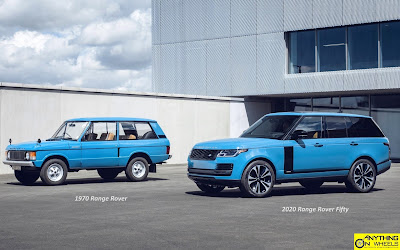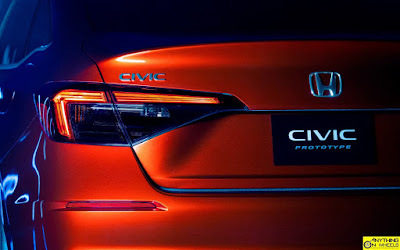While 2020 has been a year to forget for almost everybody, Land Rover had reasons to celebrate. Their flagship Range Rover turned 50 this year!
From being a single model positioned at the top of the Land Rover line-up in 1970 to a full-blown sub-brand of sorts with a four-strong lineup in 2020, Range Rover has come a long way in these 50 years. With each successive generation, Range Rover kept moving up the ladder in terms of price and positioning, always offering customers an enticing combination of ultimate luxury with go-anywhere prowess. Just as well as Range Rover was one of the pioneers of "luxury off-roading" when introduced.
For me, the best aspect of Range Rover has to be the fact those off-roading credentials do not come at the expense of aesthetics. The iconic silhouette, clamshell hood, floating roof and continuous waistline have all stood the test of time, evolving over the years to look fresh and contemporary.
As 2020 draws to a close, I thought it would be good to wrap up the year with a post dedicated to Range Rover's evolution and the many feats it accomplished along the way.
Debut
The 4x4 leisure market was growing worldwide and Jeep was making merry with its Wagoneer. Land Rover felt it's Defender was too basic to suit lifestyle audiences and take the fight to the Jeep. After making the first prototype in 1966 and fine-tuning it over the next four years, Land Rover introduced the Range Rover to critical acclaim in 1970.
Milestones
- It took 12 years for Range Rover to reach the production milestone of 100,000 units
- Sales rose over the next two decades with production crossing 500,000 units in 2002
- Over the last decade and half, Range Rover has been the growth engine for Jaguar-Land Rover contributing significantly in terms of volumes as well as revenue
Fun Facts
- Range Rover has featured in over 1,400 movies and television shows
- Range Rover has starred in five James Bond movies; That's just two short of Sean Connery and Roger Moore - both of whom starred in the lead role in 7 movies - and more than all other actors that have played James Bond
- Range Rover has been a popular choice amongst celebrities globally; Well-known personalities to have owned Range Rover include Her Majesty the Queen, basketball legend Michael Jordan, Hollywood star Tom Cruise, ex-Beatle Paul McCartney, Indian skipper Virat Kohli and a whole gamut of Bollywood stars including Amitabh Bachchan, Salman Khan, Akshay Kumar, Ranbir Kapoor, Alia Bhatt and Anushka Sharma
- At the 2012 Geneva Motor Show, Land Rover did the unthinkable and unveiled the Range Rover Evoque Convertible Concept; While many thought the world's first luxury SUV convertible would remain a concept, Land Rover went ahead and put it into production from late 2015
- A near-identical copycat of the Range Rover Evoque exists in China (where else?) in the form of Landwind X7
Staying true to its roots while remaining relevant over a span of 50 years is no mean feat. Range Rover has accomplished just that. So, how did the model evolve over the years?
Read on, to find out.
First Generation (1970 - 1994)
Now fondly called the Classic, the original Range Rover was only available as a two-door model with an aluminum Rover V8 engine, full-time four-wheel-drive and all-wheel disc brakes. It struck a chord with buyers almost immediately. The rest, as they say, is history.
It wasn't until 1981 Land Rover found the need to add a four-door model to the line-up. Though the initial models were fairly utilitarian with vinyl seats and washable dashboard made of plastic, convenience features like power steering, carpeted floors, air-conditioning, leather upholstery and wooden interior trim were added over the years. From becoming the world's first 4x4 to feature Anti-lock Braking System in 1989 to being the first-ever SUV equipped with electronic Traction Control System and automatic air suspension in 1992, this generation of Range Rovers had quite a few firsts to boast of in it's 25-year life span.
It was also during this period Range Rover's reputation for unrivalled all-terrain capability was cemented with a series of high-profile endurance runs.
- In 1972, Range Rover became the first vehicle to complete an 18,000-mile Trans-America expedition staged by the British Army including crossing the dangerous Darien Gap in South America
- In 1974, Range Rover completed a 7,500-mile trek across the Sahara Desert in just 100 days
- In 1977, Range Rover topped the 4x4 class of the 18,750-mile London-Sydney marathon, the longest-ever speed-based rally
- In 1979, Range Rover won the first-ever Paris-Dakar rally followed by another triumph in 1981
The classic Range Rover finally bowed out in 1996 after a 2-year overlap with its successor and a production run of 317,615 units.
Second Generation (1994 - 2001)
Internally named 'P38a' after the building in which it was developed, the second-generation Range Rover debuted in 1994 offering better off-road capability, better on-road behaviour, more luxurious interiors and technological advancements including an advanced electronic air suspension. The powertrain lineup expanded as well with the V8 petrol engine now available in 3.9-liter and 4.6-liter displacements in addition to a BMW-sourced 2.5-liter diesel.
In 1999, Land Rover joined hands with furniture designer Lord Linley to come up with what was the most luxurious and the most expensive Range Rover then. Inching past the six-figure price barrier (It was priced £100,000 at launch), the Linley special edition featured a hand-finished black paint job, bespoke interiors finished with black leather upholstery, piano black trim inserts and uncommon niceties like an on-board television, VCR player and satellite navigation. Just ten of these were made, making it one of the most exclusive Range Rovers you can lay your hands on!
Third Generation (2001-2012)
Range Rover entered the new millennium with the arrival of the bigger, more spacious and more luxurious third generation model, codenamed L322. As a result of this upmarket move, Range Rover had a cabin that would serve an S-Class owner just right! It was a big deal, given that none of the off-road chops Range Rovers were known for had been compromised.
Planned and developed under BMW ownership, the L322 Range Rover shared a lot of its components with the 7-Series initially. Powering this generation were V8 petrol engines from BMW until 2005 and Jaguar after that. Diesel mills were sourced from BMW first and Ford later. Technological highlights include the addition of 'virtual' instrument cluster in 2010 and the first-in-industry dual-view infotainment display. It's remarkable how both of those high-end features of the day have filtered down to entry-level cars these days.
This generation saw the nameplate expand with the introduction of the Range Rover Sport in 2005 and the Range Rover Evoque in 2011. Both of these models have established themselves as successful off-shoots of the Range Rover nameplate and are currently in their second generation.
Fourth Generation (2012 onwards)
2012 saw the introduction of the fourth-generation Range Rover, codenamed L405. Bragging rights this time came in the form of its aluminium construction, a leaf taken out of Jaguar's book. By becoming the world's first SUV to make significant use of the light metal, this generation of Range Rovers benefitted from reduced weight, improved strength and increased efficiency.
As it did with every prior generation, Range Rover moved further upmarket in price and positioning. The fact that exterior styling and interior appointments matched that move helped its cause. Engine options include 3.0-liter V6 petrol, 5.0-liter V8 petrol, 3.0-liter V6 diesel and 4.4-liter V8 diesel paired to a ZF-sourced 8-speed automatic transmission.
The inevitable electrification happened in 2013 with the first Range Rover Hybrid making its debut. Other high points include the launch of the Range Rover Sport SVR - the world's fastest SUV at the time - in 2014 and the addition of the sexy Velar as the fourth model of the Range Rover line-up in 2018.
During this tenure, Range Rover was back doing what it did best in its first iteration.
- In 2013, three Range Rover Hybrids completed a 9,950-mile endurance expedition following the ancient Silk Route from the UK to India
- In 2018, a Range Rover Sport Plug-in Hybrid became the first vehicle ever to climb the towering 45-degree, 999-step staircase to Heaven's Gate in China
Range Rover Fifty
To commemorate the 50th anniversary of the Range Rover, Land Rover introduced the Range Rover Fifty earlier this year. Based on the Autobiography trim level, this special edition is an ode to the original Range Rover with a production run that's limited to 1,970 units. Yes, you got that right. 1970 was when the Range Rover was originally introduced.
Being a special commemorative edition, the Range Rover Fifty gets a slew of bespoke features like exterior accents painted in Auric Atlas (that's black for you and me), unique 22-inch alloy wheels, a special colour palette including Tuscan Blue, Bahama Gold and Davos White that are replicated from the original's palette. A special 'Fifty' script can be seen on the exterior badging, headrests, dashboard and the illuminated doorsills. There's also a '1 of 1970' badge on the center console to remind owners of their ride's exclusivity.
What does the future hold?
With the current-generation model on its final legs, a new Range Rover is likely to debut in the next year or two. With electrification and autonomy being the buzz words in the industry, I'm sure the new Range Rover is going to embrace one or both of them in some form or the other. It's going to be interesting. Just wait for the baton to be passed on!






















































